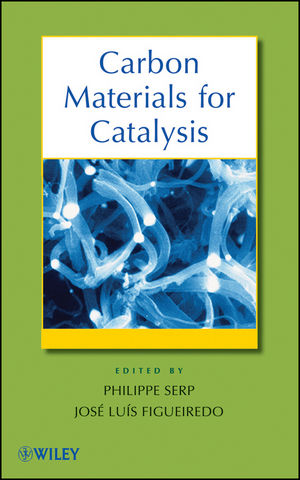Carbon Materials for CatalysisISBN: 978-0-470-17885-0
Hardcover
608 pages
December 2008
 |
||||||
1.1 Introduction.
1.2 Formation of Carbons.
1.3 Structure and Properties of Carbons.
1.4 Reactions of Carbons.
1.5 Summary and Conclusions.
1.6 References.
2. Surface chemistry of carbon materials (Teresa J. Bandosz) .
2.1 Introduction .
2.2 Surface functionalities.
2.3 Surface modifications.
2.4 Characterization of surface chemistry.
2.5 Role of surface chemistry in the reactive adsorption on activated carbons.
2.6 Role of carbon surface chemistry in catalysis.
2.7 References.
3. Molecular Simulations applied to adsorption on and reaction with carbon (Zhonghua (John) Zhu).
3.1 Introduction.
3.2 Molecular simulation methods applied to carbon reactions.
3.3 Hydrogen adsorption on and reaction with carbon.
3.4 Carbon reactions with oxygen containing gases.
3.5 Metal-Carbon interactions.
3.6 Conclusions.
3.7 References.
4. Carbon as catalyst support (Francisco Rodr¡guez-Reinoso and Antonio Sepúlveda-Escribano).
4.1 Introduction.
4.2 Carbon properties affecting its role as catalyst support.
4.3 Preparation of carbon supported catalysts.
4.4 Applications.
4.5 Summary.
4.6 References.
5. Preparation of carbon-supported metal catalysts (Johannes H. Bitter and Krijn P. de Jong).
5.1 Introduction.
5.2 Impregnation/adsorption.
5.3 Deposition Precipitation.
5.4 Emerging preparation methods.
5.5 Concluding remarks.
5.6 References.
6. Carbon as catalyst (Jos‚ Luis Figueiredo and Manuel Fernando R. Pereira).
6.1 Introduction.
6.2 Factors affecting the performance of a carbon catalyst.
6.3 Reactions catalyzed by carbons.
6.4 Conclusions.
6.5 References.
7. Catalytic properties of nitrogen-containing carbons (Hanns-Peter Boehm).
7.1 Introduction.
7.2 Nitrogen-doping of carbons.
7.3 Catalysis of oxidation reactions with dioxygen.
7.4 Catalysis of aging of carbons.
7.5 Catalysis of dehydrochlorination reactions.
7.6 Conclusions on the mechanism of catalysis by nitrogen-containing carbons.
7.7 References.
8. Carbon anchored metal complex catalysts (Cristina Freire and Ana Rosa Silva).
8.1 Introduction.
8.2 General methods for molecule immobilization.
8.3 Methods for immobilization of transition metal complexes onto carbon materials .
8.4 Application of coordination compounds anchored onto carbon material in several catalytic reactions .
8.5 Carbon supported organometallic compounds in hydrogenation and hydroformylation catalytic reactions .
8.6 Carbon supported organometallic complexes in polymerisation reaction of olefins.
8.7 Concluding Remarks.
8.8 References.
9. Carbon nanotubes and nanofibers in catalysis (Philippe Serp).
9.1 Introduction.
9.2 Catalytic growth of carbon nanofibers and carbon nanotubes.
9.3 Why can CNTs or CNFs be suitable to be used in catalysis?.
9.4 Preparation of supported catalysts on CNTs and CNFs.
9.5 Catalytic performance of CNT- and CNF-based catalysts.
9.6 Conclusion.
9.7 References.
10. Carbon gels in catalysis (Carlos Moreno-Castilla).
10.1 Introduction.
10.2 Carbon gels: preparation and surface properties.
10.3 Metal-doped carbon gels.
10.4 Catalytic reactions of metal-doped carbon gels.
10.5. Conclusions.
10.6 References.
11. Carbon monoliths in catalysis (Karen M. de Lathouder, Edwin Crezee, Freek Kapteijn and Jacob A. Moulijn).
11.1 Introduction.
11.2 Carbon.
11.3 Monolithic structures.
11.4 Carbon monoliths.
11.5 Carbon monoliths in catalysis: an overview.
11.6 Example of carbon monoliths as catalyst support material.
11.7 Evaluation and Practical Considerations.
11.8 Conclusions.
11.9 References.
12. Carbon materials as supports for fuel cells electrocatalysts (Frédéric Maillard, Pavel A. Simonov and Elena R. Savinova).
12.1 Introduction.
12.2 Structure and morphology of carbon materials.
12.3 Physicochemical properties of carbon materials relevant to the fuel cell operation.
12.4 Preparation of carbon-supported electrocatalysts.
12.5 Structural characterization of carbon-supported metal catalysts.
12.6 Influence of carbon supports on the performance of the catalytic layers in PEMFCs.
12.7 Corrosion and stability of carbon-supported catalysts.
12.8 Conclusions and outlook.
12.9 References.
13. Carbon materials in photocatalysis (Joaquim Lu¡s Faria and Wendong Wang).
13.1 Introduction.
13.2 Different carbon materials employed to modify TiO2 in photocatalysis.
13.3. Synthesis and characterization of carbon-TiO2 composites.
13.4 Photodegradation on carbon containing surfaces.
13.5. Role of the carbon phase in heterogeneous photocatalysis.
13.6. Concluding remarks.
13.7 References.
14. Carbon-based sensors (Jun Li).
14.1 Introduction.
14.2 The physico-chemical properties of sp2 carbon materials relevant to carbon sensors.
14.3 Carbon-based sensors.
14.4 Summary.
14.5 References.
15. Carbon Supported Catalysts for the Chemical Industry (Venu Arunajatesan, Baoshu Chen, Konrad Möbus, Daniel J. Ostgard, Thomas Tacke and Dorit Wolf).
15.1 Introduction.
15.2 Properties and Requirements of Carbon Materials as Catalyst Supports for Industrial Applications.
15.3 Industrial manufacturing of carbon supports.
15.4 Manufacturing of Carbon Supported Catalysts.
15.5 Reaction Technology.
15.5.1 Batch stirred-tank and loop reactors.
15.6 Industrial Applications.
15.7 Testing and Evaluation of Carbon Catalysts.
15.8 Conclusions and Outlook.
15.9 References.



